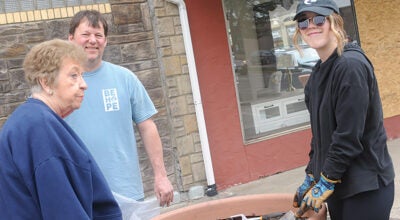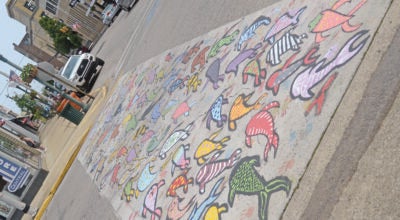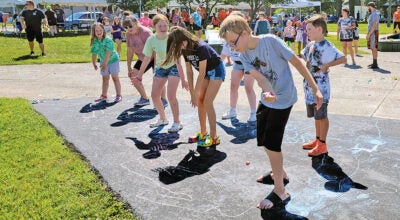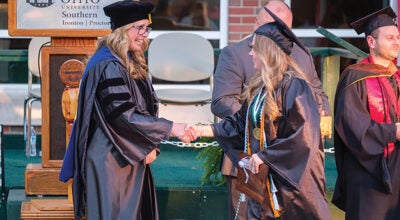Digging in the dirt
Published 12:00 am Friday, June 2, 2023

- LEFT: Richard Hess, of Ashland RIGHT: Opus sectile, Second Temple pavement stone, unearthed by Hess. (Submitted photo)
By Benita Heath (Additional writing by Heath Harrison)
Richard Hess, of Ashland, says he has always had an interest in ancient civilizations.
“It was in early grade school, I had a fascination with Egypt, ancient Rome, ancient Greece, the Babylonian empire, the Assyrians,” he said. “My mother is actually the one that kind of pointed me in that direction. She love to read and had a lot books n ancient civilizations and by Agatha Christie, who was married to a very famous archeologist. Agatha Christie would incorporate archeology in some of her books. So my interest started in grade school — and going to Vacation Bible School in summer, you talked about the biblical lands and that sparked my interest and I’ve had a love for that ever since.”
An Ironton native and graduate of the city’s high school, Hess retired as a distribution line coordinator from Kentucky Power in 2022. In addition to serving as a lifeguard at the Huntington YMCA, he has spent his time in retirement enrolled in a theology course from Ariel College of the Bible in San Antonio, Texas.
“I’ve a distanced learning course,” he said. “I want to get more of a Biblical background and then pursue archeology,” he said.
Hess said his interest is in Biblical archeology.
“Early archeologists in 1800s, the ones who explored Egypt and Israel — a lot of them were theologians,” he said. “Not all archeologists are secular, but, many who use the Bible for locations — geographical locations or kings and princesses. There are lot of Christian archeologists, but there are secular archeologists who use the scriptures as a map.”
Hess considers himself an amateur archeologist, but his interest has taken him overseas, where he participated in digs four years ago.
“I helped out on several sites on outside of Jerusalem,” he said. “The biggest is the Temple Mount sifting project. The Palestinians did a dig on top of Temple Mount, the southern section on corner. They removed a lot of soil, around 10,000 tons of dirt and the dumped the dirt in the Kidron Valley. Israeli archeologists caught wind of it and went in and grabbed all the dirt up and started sifting it. I helped for two weeks. It is wet sifting. You put dirt in screen area and hose it down and see what pops up.”
Hess said, during this sifting, he found ancient coins and pottery shards.
“Archeologists love finding coins, because they can determine dates,” he said. “A lot of the coins have the Roman emperors on there. It’s kind of like the Polaroid pictures of today. You find a lot of pottery shards and you can use those to date the different dynasties. They can take analysis of what pottery is made of and can pinpoint exact the location where it was made.”
Hess said he also found opus sectile.
“It’s floor paving of the second temple,” he said. “You’re talking about the size of a football field, what this flooring would look like. I found several of those. I was really excited, because that pertains to the temple itself. You never know if Jesus walked on that flooring or some of the apostles, or Pontius Pilate or somebody else important. It’s really exciting.”
In addition to this project, Hess has made several travels as a tourist to archeological site.
“I’ve been to Greece, Turkey, Egypt, traveling for studying and touring,” he said. “I’ve been to Pompeii, where I watched National Geographic archeologists do some excavation on that site,” he said of the location of the 79 A.D eruption of Mount Vesuvius. “I got to talk to them for a few minutes and it was quite exciting what they were doing. They had come across 20-30 skeletons, where people had huddled together from that volcanic ash.”
Earlier this year, Hess traveled to Egypt, where he visited the site of the pharaoh Tutankhamen’s tomb, marking the 100th anniversary of its excavation by Howard Carter.
“And I’ll be going back to Israel in June, with Dr. Randall price for a one day sifting project,” Hess said.
A member of First Baptist Church in Ironton, Hess said he has a Power Point presentation, called “Digging up the Bible,” which he takes to local churches.
“It’s to spark interest in Old and New Testament archeology,” he said. “I love studying ancient history and archeology. There’s probably been a dozen — some ancient history professors have put it in the 30s — of how civilizations have come and gone. I think people out to learn history so we can understand what is going on today.”
Hess, whose residence is filled with things he has found, as well as objects he has purchased from archeology dealers, such as tear bottles and crucifixion nails, said his interest is intertwined with his faith.
“The reason I love studying archeology, it verifies the geographical locations,” he said. “I love reading and studying the Bible, like where Bethlehem is or Nineveh is,” he said. “It verifies kings like Nebuchadnezzar or the Egyptian pharaohs, and other rulers, like King David. They found this stone that has “House of David.” If there was a House of David, then there must have been a David. So it verifies my belief in the biblical scriptures and my faith.” a
EDITOR’S NOTE: This story was originally started by writer Benita Heath. After her death in January, Heath Harrison completed the piece.





